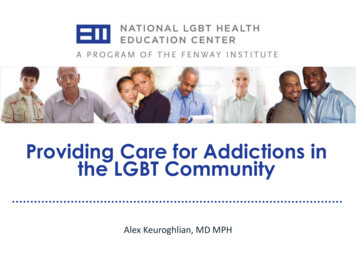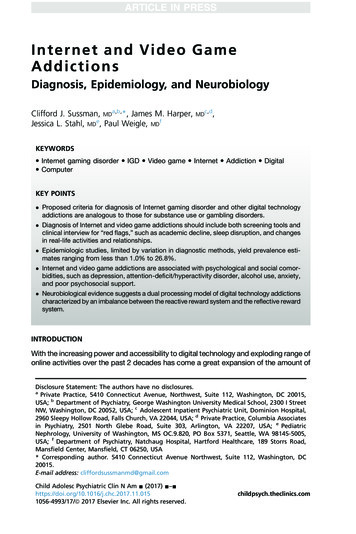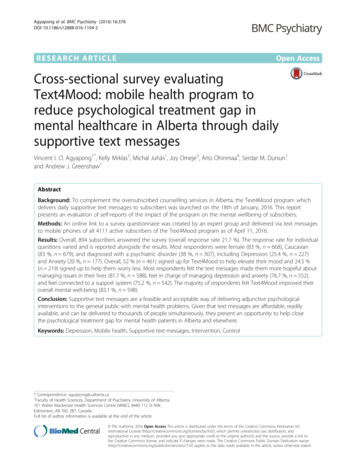
Transcription
Providing Care for Addictions inthe LGBT CommunityAlex Keuroghlian, MD MPH
Learning Objectives1. Describe the relationship of minority stress to thedisproportionate prevalence of substance usedisorders among LGBT people;2. Explain how to tailor evidence-based addictionstreatments for LGBT populations;3. Identify specific behavioral health integrationstrategies to better address substance use disordersin the LGBT community.
Minority Stress hologicalProcessesInternal icalHealthProblems
Minority Stress and SubstanceUse Disorders LGBT people have disproportionate substance usedisorder (SUD) prevalence as a downstream effect ofminority stress; Substance use mediates the relationship between lifestress and sexual risk among LGBT people; SUDs are associated with condomless intercourse andHIV infection; SUDs are barriers to HIV pre-exposure prophylaxis(PrEP) adherence in populations at high risk for HIV.
Substance Use among Lesbian,Gay, and Bisexual (LGB) People LGB-identified youth initiate alcohol and illicit druguse earlier than non-LGB identified youth; Lesbian and bisexual women are at greater risk foralcohol and drug use disorders; Gay and bisexual men are at greater risk of drug usedisorders; Bisexual people are at higher risk for substance usedisorders.
A Closer Look: Addictions amongTransgender People Studies examining substance use disorders (SUDs)among transgender people are rare; Reporting of gender identity data (e.g., transgenderstatus) in SUD-related research is limited; In the few studies that exist, transgender people haveelevated prevalence of alcohol and illicit drug usecompared with the general population.
Anti-Transgender Discriminationand Victimization Transgender people are at high risk for verbal,physical and sexual victimization; A national study of more than 6000 transgenderpeople found 63% had experienced a serious act ofdiscrimination (e.g., medical service denial, eviction,bullying, or physical/sexual assault).
Gender Minority Stress andSubstance Use among TransgenderPeople Psychological abuse among transgender women as aresult of nonconforming gender identity orexpression is associated with: 3-4x higher odds of alcohol, marijuana, or cocaine use 8x higher odds of any drug use Among transfeminine youth, gender-relateddiscrimination is associated with increased odds ofalcohol and drug use.
Gender Minority Stress andSubstance Use among TransgenderPeople 35% of transgender people who experienced school-related verbal harassment, physical assault, sexualassault, or expulsion reported using substances tocope with transgender- or gender nonconformityrelated mistreatment; Psychological stress of health care access disparitiesfaced by transgender people is believed to contributeto worse mental health, including disproportionatesubstance use as a coping strategy.
Substance Use Disorders amongTransgender Adults Among 452 transgender adults in MA, increased odds of SUDtreatment history plus recent substance use were associatedwith: intimate partner violence PTSD public accommodations discrimination low income unstable housing sex work SUDs increasingly viewed as downstream effects of chronicgender minority stressKeuroghlian et al. (2015)
Minority Stress and SubstanceUse among Transgender AdultsKeuroghlian et al. (2015)
PTSD and AntiretroviralAdherenceInteraction Effect of PTSD and DissociationOn Antiretroviral Medication AdherencePTSDKeuroghlian et al., (2011)
PTSD and AntiretroviralAdherence Importance of psychosocial interventions that targetposttraumatic stress symptoms to maximizeantiretroviral adherence in community populations; Integration of trauma-focused treatment services intoantiretroviral medication management may effectivelyimprove adherence.
Substance Use and PosttraumaticStress Co-occurrence of SUDs with posttraumatic stresssymptoms is highly prevalent: Associated with increased treatment costs, decreasedtreatment adherence, and worse physical and mentalhealth outcomes; Substance use is a common avoidance strategy forposttraumatic stress.
Integrated Treatment forAddictions and Trauma Recent shift in focus toward trauma-informed carecreated a favorable environment in community SUDtreatment settings for evidence-based integratedtherapies that also target trauma and stress; Integrated treatments for SUDs and posttraumaticstress are well tolerated and improve both SUDs andPTSD.
Limitations of Extant Interventions Designed for patients meeting full diagnostic criteriafor PTSD; Lack generalizability to treat subthreshold traumaand stress symptoms resulting more broadly fromsexual or gender minority stress; Existing interventions not tailored to increase PrEPadherence or improve HIV prevention self-care.
An Integrated HIV PreventionIntervention (10 sessions) Module 1: Life-Steps (1 session) Module 2: Sexual Decision Making (1 session) Module 3: Cognitive-behavioral Therapy for SUDs (4sessions) Module 4: Cognitive Processing Therapy for GenderMinority Stress (3 sessions) Module 5. Summary, Review of Past Modules, andRelapse Prevention (1 session)
An Integrated HIV PreventionInterventionDecrease substance usedisordersIntegrated interventionTailored for LGBTsubpopulations based onminority stress theoryModules 1 and 2Decrease posttraumaticstress symptomsIncrease in weeks withHIV risk coverage:Adequate PrEP adherenceORConsistent condom utilizationORNo sexual intercourse
Tailoring Evidence-basedTreatments for LGBT Patients
Minority Stress Treatment Principlesfor Behavioral Health Clinicians Normalize adverse impact of minority stress Facilitate emotional awareness, regulation, and acceptanceEmpower assertive communicationRestructure minority stress cognitionsValidate unique strengths of LGBT peopleFoster supportive relationships and communityAffirm healthy, rewarding expressions of sexualityand gender
Cognitive-behavioral Therapy forSubstance Use Disorders Adapting selected topics and practice exercises from themanual by Carroll Focus: Coping With Craving (triggers, managing cues, craving control); Shoring Up Motivation and Commitment (clarifying andprioritizing goals, addressing ambivalence); Refusal Skills and Assertiveness (substance refusal skills,passive/aggressive/assertive responding); All-Purpose Coping Plan (anticipating high-risk situations,personal coping plan); HIV Risk Reduction.
Cognitive-behavioral Therapy forSubstance Use Disorders Tailoring for LGBT patients: Minority stress-specific triggers for cravings (e.g.nonconformity-related discrimination and victimization,expectations of rejection, identity concealment, andinternalized homophobia/transphobia); SUDs as barriers to personalized goals of adequate PrEPadherence or consistent condom use; For transgender patients: assertive substance refusal withnon-transgender sex partners; HIV risk from hormone andsilicone self-injections; SUDs as barriers to personalizedgoal of successful gender affirmation.
Cognitive Processing Therapy forPTSD Adapting selected components of cognitiveprocessing therapy for PTSD Focus: Education about posttraumatic stress; Writing an Impact Statement to help understand howtrauma influences beliefs; Identifying maladaptive thoughts about trauma linked toemotional distress; Decreasing avoidance and increasing resilient coping.
Cognitive Processing Therapy forMinority Stress Tailoring for LGBT Patients: Focus on how LGBT-specific stigma causes posttraumatic stress(e.g. avoidance, mistrust, hypervigilence, low self-esteem); Attributing challenges to minority stress rather than personalfailings; Impact Statement on how discrimination and victimizationaffect beliefs (e.g. expecting rejection, concealment needs,internalized homophobia/ transphobia); Decreasing avoidance (e.g. isolation from LGBT community ormedical care); Impact of minority stress on PrEP adherence or condom use.
Behavioral Health Integration(BHI)
What are the Types of BHI?Spectrum : Coordinated Co-Located Integrated(Heath, 2013)Heath 2013
Coordinated Separate systems and facilities, issue driven Level 1 Minimal Collaboration Level 2 Basic Collaboration at a DistanceHeath 2013
Co-Located Level 3 Basic collaboration on-site Same facility, separate system Level 4 Close collaboration on-site with some systemintegration Same facility, some shared systems Driven by complex patients, regular face-to-faceinteractions, basic understanding of cultureHeath 2013
Integrated Level 5 Close collaboration approaching an integratedpractice Same facility, some shared space, toward same team Level 6 Full collaboration in a transformed/merged integratedpractice Sharing all the same space within same facility One integrated system of team care, roles andcultures blendedHeath 2013
Why BHI?1. Improving experience of care2. Improving health of populations3. Reducing per capita costs of health careInstitute of Healthcare Improvement
Screening, Brief Intervention, andReferral to Treatment (SBIRT)Evidence-based practice to identify, reduce, andprevent problematic alcohol and drug use:1. Screening2. Brief Intervention3. Referral to Treatment
Co-occurring Opioid Use andPsychiatric Disorders: Fenway’sModel 648 Fenway patients with an opioid use disorder,mostly alongside other psychiatric illnesses Dual diagnosis approach to treatment Integration of addictions treatment with mentalhealth services Fenway’s model: Substance Abuse TreatmentProgram (250 patients/year) within Behavioral HealthDepartment
Summary LGBT people have disproportionately high prevalenceof substance use disorders compared with thegeneral population; Higher prevalence of addictions is a consequence ofpervasive minority stress that occurs in the context ofstigma-related discrimination and victimization; Substance use among LGBT people is often a copingstrategy for trauma-related symptoms and can beassociated with poor self-care, includingcompromised engagement in care for HIV treatmentand prevention;
Summary Evidence-based addictions treatment practices canbe tailored for LGBT patients, and integrated withtrauma-focused therapies adapted to addressminority stress; Behavioral health integration is a systems-levelapproach for health centers to better addresssubstance use disorders, including the opioidepidemic, among LGBT people.
THANK YOU
References Babor, T. F., McRee, B. G., Kassebaum, P. A., Grimaldi, P. L., Ahmed, K., & Bray, J. (2007). Screening, Brief Intervention, and Referral to Treatment (SBIRT) toward apublic health approach to the management of substance abuse. Substance abuse,28(3), 7-30.Baral, S.D., Poteat, T., Strömdahl, S., Wirtz, A.L., Guadamuz, T.E., Beyrer, C. (2013)Worldwide burden of HIV in transgender women: a systematic review and metaanalysis. Lancet infectious disease 13:214–22.Brennan, J., Kuhns, L.M., Johnson, A.K., Belzer, M., Wilson, E.C., Garofalo, R. (2012)Adolescent Medicine Trials Network for HIVAI. Syndemic theory and HIV-relatedrisk among young transgender women: the role of multiple, co-occurring healthproblems and social marginalization. Am J Public Health; 102(9):1751-7.Budge, S. L., Adelson, J. L., & Howard, K. A. (2013). Anxiety and depression intransgender individuals: the roles of transition status, loss, social support, andcoping. Journal of consulting and clinical psychology, 81(3), 545.Bostwick, W.B., Meyer, I., Aranda, F., et al. (2014). Mental health and suicidalityamong racially/ethnically diverse sexual minority youths. American journal of publichealth; 104:1129e36.
References Carroll KM. (1998) A cognitive-behavioral approach: Treating cocaineaddiction. Rockville, MD: National Institute on Drug Abuse. Cochran, S. D., Sullivan, J. G., & Mays, V. M. (2003). Prevalence ofmental disorders, psychological distress, and mental health servicesuse among lesbian, gay, and bisexual adults in the United States.Journal of consulting and clinical psychology, 71(1), 53. Campo, J. V., J. A. Bridge, J.A., et al. (2015). Access to Mental HealthServices: Implementing an Integrated Solution. JAMA pediatrics,169(4):299-300. Deutsch, M.B., Glidden, D.V., Sevelius, J., et al. (2015) HIV preexposure prophylaxis in transgender women: a subgroup analysis ofthe iPrEx trial. Lancet HIV 2:e512–9. Flentje, A., Bacca, C.L., Cochran,B.N. (2015) Missing data in substance abuse research? Researchers'reporting practices of sexual orientation and gender identity. DrugAlcohol Depend; 147:280-4.
References Fredriksen-Goldsen, K. I., Kim, H. J., Barkan, S. E., Muraco, A., & Hoy-Ellis, C.P. (2013). Health disparities among lesbian, gay, and bisexual older adults:results from a population-based study. American journal of public health,103(10), 1802-1809. Grant, J.M., Mottet, L.A., Tanis, J., Harrison, J., Herman, J.L., Keisling, M.(2011) Injustice at every turn: A report of the National TransgenderDiscrimination Survey. Washington, DC: National Center for TransgenderEquality, and the National Gay and Lesbian Task Force. Green, K. E., & Feinstein, B. A. (2012). Substance use in lesbian, gay, andbisexual populations: an update on empirical research and implications fortreatment. Psychology of Addictive Behaviors, 26(2), 265. Haas, A.P., Rodgers, P.L., & Herman, J.L. (2014). Suicide Attempts AmongTransgender and Gender Non-Conforming Adults: Findings of the NationalTransgender Discrimination Survey. American Foundation for SuicidePrevention and The Williams Institute.
References Herbst, J.H., Jacobs, E.D., Finlayson, T.J., McKleroy, V.S., Neumann, M.S., & Crepaz, N. (2008) Estimating HIV prevalence and risk behaviors of transgender persons inthe United States: a systematic review. AIDS behavior 12:1–17.Hottes, T. S., Bogaert, L., Rhodes, A. E., Brennan, D. J., & Gesink, D. (2016). Lifetimeprevalence of suicide attempts among sexual minority adults by study samplingstrategies: a systematic review and meta-analysis. American journal of publichealth, 106(5), e1-e12.Hatzenbuehler, M. L. (2009). How does sexual minority stigma “get under theskin”? A psychological mediation framework. Psychological bulletin, 135(5), 707730.Heath, B., Wise Romero, P., et al. (2013). A standard framework for levels ofintegrated healthcare. Washington DC: SAMHSA-HRSA Center for Integrated HealthSolutions.Institute of Healthcare Improvement. Accessed September 15, 2016 Pages/default.aspx.Institute of Medicine (US). Committee on Treatment of Posttraumatic StressDisorder.Treatment of posttraumatic stress disorder: An assessment of theevidence. National Academies Press, Washington, DC. 2008.
References Kann, L., Olsen, E.O., McManus, T., et al. (2011). Sexual identity, sex of sexual contacts, and health-risk behaviors among students in grades 9-12: Youth riskbehavior surveillance. MMWR Surveill Summ, 60:1e133. Cited by: Facts AboutSuicide. The Trevor Project Website, uicide.Katon, W. J., Lin, E.H. et al. (2010). Collaborative care for patients with depressionand chronic illnesses. The New England journal of medicine, 363(27): 2611-2620.Katon, W. (2013). Health reform, research pave way for collaborative care formental illness. Interview by Bridge M. Kuehn. Journal of the American MedicalAssociation 309(23): 2425-2426.Kessler, R. C., Berglund, P., et al. (2005) Lifetime prevalence and age-of-onsetdistributions of DSM-IV disorders in the National Comorbidity Survey Replication.Archives of general psychiatry 62(6): 593-602.Kessler, R. C., Avenevoli, S. et al. (2012). Prevalence, persistence, andsociodemographic correlates of DSM-IV disorders in the National ComorbiditySurvey Replication Adolescent Supplement. Archives of general psychiatry 69(4):372-380.
References Kessler, R. C., Avenevoli, S. et al. (2012). "Severity of 12-month DSM-IV disorders in the National Comorbidity Survey Replication Adolescent Supplement." Archives ofgeneral psychiatry 69(4): 381-389.Keuroghlian, A.S., Kamen, C.S., Neri, E., Lee, S., Liu, R., & Gore-Felton, C. (2011)Trauma, dissociation and antiretroviral adherence among persons living withHIV/AIDS. Journal of psychiatric research; 45(7): 942-948.Keuroghlian, A.S., Shtasel, D., Bassuk, E.L. (2014). Out on the street: a public healthand policy agenda for lesbian, gay, bisexual, and transgender youth who arehomeless. The American journal of orthopsychiatry; 84(1):66-72.Keuroghlian, A.S., Reisner, S.L., White, J.M., & Weiss, R.D. (2015) Substance use andtreatment of substance use disorders in a community sample of transgenderadults. Drug and alcohol dependence; 152: 139-146.Killeen, T.K., Back, S.E., Brady, K.T. (2015). Implementation of integrated therapiesfor comorbid post-traumatic stress disorder and substance use disorders incommunity substance abuse treatment programs. Drug Alcohol Rev. 2015;34(3):234-41.
References McCauley, J.L., Killeen, T., Gros, D.F., Brady, K.T., Back, S.E. (2012). Posttraumatic Stress Disorder and Co-Occurring Substance Use Disorders: Advances inAssessment and Treatment. Clin Psychol (New York); 19(3). 283-304.McGovern, M.P., Lambert-Harris, C., Xie, H., Meier, A., McLeman, B., Saunders, E.(2015) A randomized controlled trial of treatments for co-occurring substance usedisorders and post-traumatic stress disorder. Addiction; 110(7):1194-204.Mechanic, D., & Olfson, M. (2016). The relevance of the Affordable Care Act forimproving mental health care. Annual review of clinical psychology, 12, 515-542.Melek, S., Norris, D. et al. (2014). "Economic impact of integrated medicalbehavioral healthcare: Implications for psychiatry." Arlington VA: AmericanPsychiatric Association.Mimiaga, M.J., Closson, E.F., Kothary, V., Mitty, J.A. (2014). Sexual partnerships andconsiderations for HIV antiretroviral pre-exposure prophylaxis utilization amonghigh-risk substance using men who have sex with men. Arch Sex Behav;43(1):99106.
References Nuttbrock, L., Bockting, W., Rosenblum, A., Hwahng, S., Mason, M., Macri, M.,Becker, J. (2013) Gender abuse, depressive symptoms, and HIV and othersexually transmitted infections among male-to-female transgender persons: athree-year prospective study. Am J Public Health; 103(2):300-307. Oldenburg, C.E., Mitty, J.A., Biello, K.B., Closson, E.F., Safren, S.A., Mayer, K.H.,Mimiaga, M.J. (2015). Differences in Attitudes About HIV Pre-ExposureProphylaxis Use Among Stimulant Versus Alcohol Using Men Who Have Sexwith Men. AIDS Behav. Pachankis, J. E. (2015). A transdiagnostic minority stress treatment approachfor gay and bisexual men’s syndemic health conditions. Archives of SexualBehavior, 44(7), 1843-1860. Paul, J. P., Catania, J., Pollack, L., Moskowitz, J., Canchola, J., Mills, T., . & Stall,R. (2002). Suicide attempts among gay and bisexual men: lifetime prevalenceand antecedents. American journal of public health, 92(8), 1338-1345.
References Peek, C.J. and the National Integration Academy Council. (2013) Lexicon for Behavioral Health and Primary Care Integration: Concepts and DefinitionsDeveloped by Expert Consensus. AHRQ Publication No.13-IP001-EF. Rockville, MD:Agency for Healthcare Research and Quality. 2013. Available t/files/Lexicon.pdf.Perou, R., Bitsko, R.H. et al. (2013). "Mental health surveillance among children-United States, 2005-2011." Morbidity and mortality weekly report. Surveillancesummaries 62 Suppl 2: 1-35.Pham, H. H., Cohen, M. et al. (2014). The Pioneer accountable care organizationmodel: improving quality and lowering costs. The journal of the American MedicalAssociation 312(16): 1635-1636.Reback, C.J., Fletcher, J.B. (2014) HIV prevalence, substance use, and sexual riskbehaviors among transgender women recruited through outreach. AIDSBehav;18(7):1359-67Reisner, S. L., White, H. J., Gamarel, K. E., Keuroghlian, A. S., Mizock, L., &Pachankis, J. E. (2016). Discriminatory Experiences Associated With PosttraumaticStress Disorder Symptoms Among Transgender Adults. Journal of counselingpsychology (in press).
References Resick, P.A., Schnicke, M.K. (1992). Cognitive processing therapy for sexual assault victims. J Consult Clin Psychol; 60(5):748-56.Roberts, N.P., Roberts, P.A., Jones, N., Bisson, J.I. (2015) Psychologicalinterventions for post-traumatic stress disorder and comorbid substanceuse disorder: A systematic review and meta-analysis. Clin PsycholRev;38:25-38.Rowe, C., Santos, G.M., McFarland, W., Wilson, E.C. (2015). Prevalence andcorrelates of substance use among trans female youth ages 16-24 years inthe San Francisco Bay Area. Drug Alcohol Depend; 147:160-6.Safren, S. A., Otto, M. W., Worth, J. L., Salomon, E., Johnson, W., Mayer, K.,& Boswell, S. (2001). Two strategies to increase adherence to HIVantiretroviral medication: life-steps and medication monitoring. Behaviourresearch and therapy, 39(10), 1151-1162.Substance Abuse and Mental Health Services Administration, LeadingChange: A Plan for SAMHSA’s Roles and Actions 2011–2014. HHSPublication No. (SMA) 11-4629. Rockville, MD: Substance Abuse andMental Health Services Administration, 2011.
Learning Objectives 1. Describe the relationship of minority stress to the disproportionate prevalence of substance use disorders among LGBT people; 2. Explain how to tailor evidence-based addictions treatments for LGBT populations; 3. Identify specific behavioral health integration strategies to better address substance use disorders










